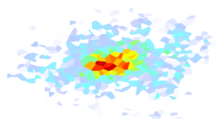3. User’s Guide¶
ShakeMap originated primarily as an internet-based system to provide real-time displays of earthquake shaking. Although the online color-coded intensity maps are the most visible result of the ShakeMap system and are the most commonly accessed and downloaded products, they are just one representation of the ShakeMap output. ShakeMap also produces grids of peak ground acceleration (PGA) and velocity amplitudes (PGV), peak spectral response values (PSA), instrumental intensities, seismic station files, fault files, regression plots, contours, metadata, and uncertainty estimates. The ShakeMap webpages also serve a variety of formats, including PDF, KML, XML, GeoJSON, GIS shape files, ESRI Raster, and a host of other formats and products for varied user needs and applications.
In this User’s Guide, after some background, we present the range of ShakeMap products and describe the available formats. The different automated mechanisms to receive and utilize ShakeMap—including GIS Web Services, GeoJSON feeds, and ShakeCast—are described and links are provided. Many users also take advantage of real-time ShakeMaps, as well as older events and earthquake planning scenarios, so we describe the three primary ShakeMap repositories: real-time ShakeMaps, historic ShakeMap Atlas events, and collections of Scenario ShakeMaps.
Next is an overview of the current ShakeMap users and applications. Beyond quickly assessing the overall domain of shaking, ShakeMap is used across many sectors: planning and response, loss estimation, financial services, education and outreach, and engineering and seismological research. We provide examples of each. The section that follows expands on how ShakeMap integrates with the related systems of DYFI, ShakeCast, and PAGER. Lastly, and importantly, are Disclaimers that users should be aware of and refer to when employing ShakeMap as part of their post-earthquake decision making.
